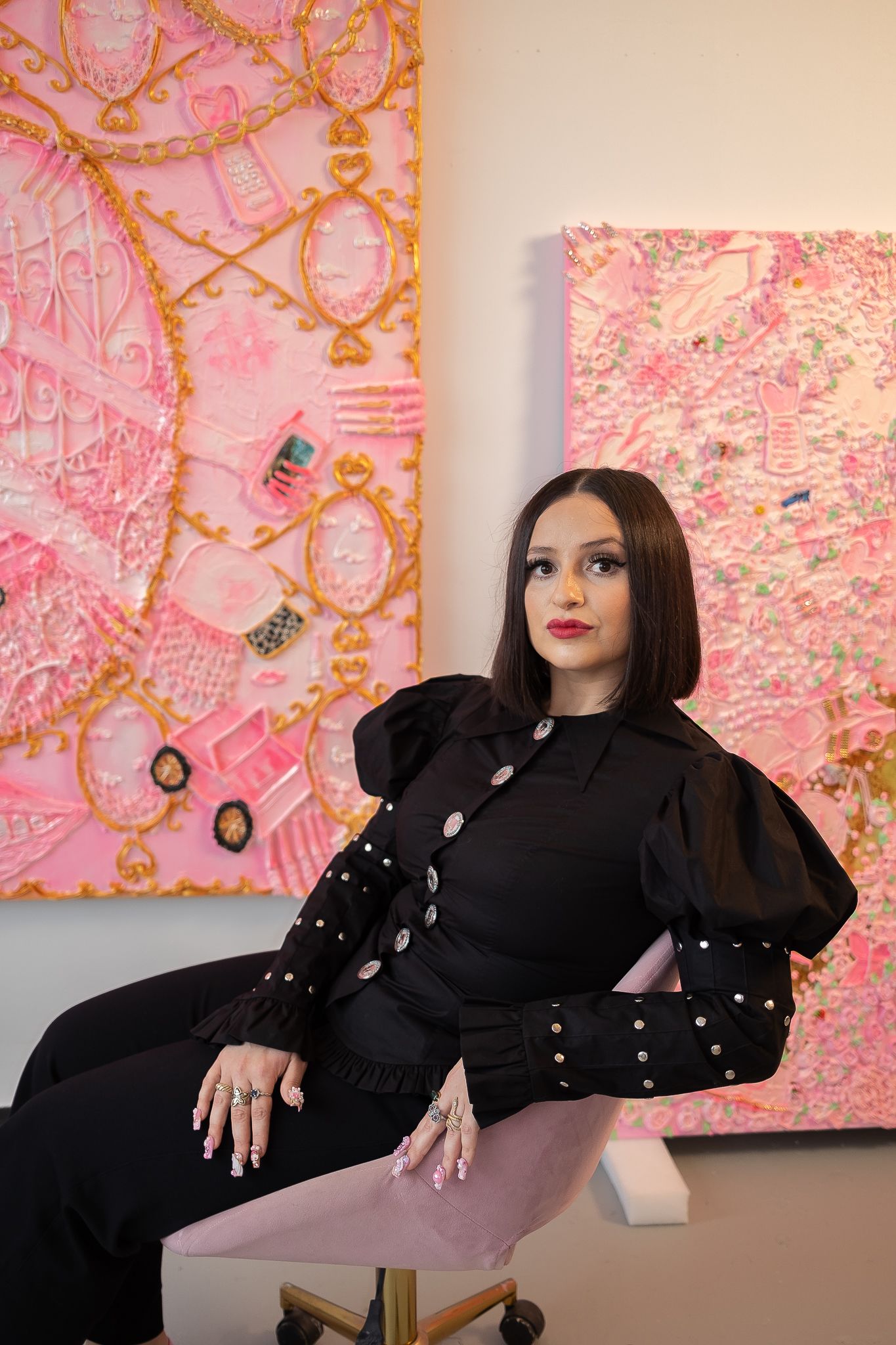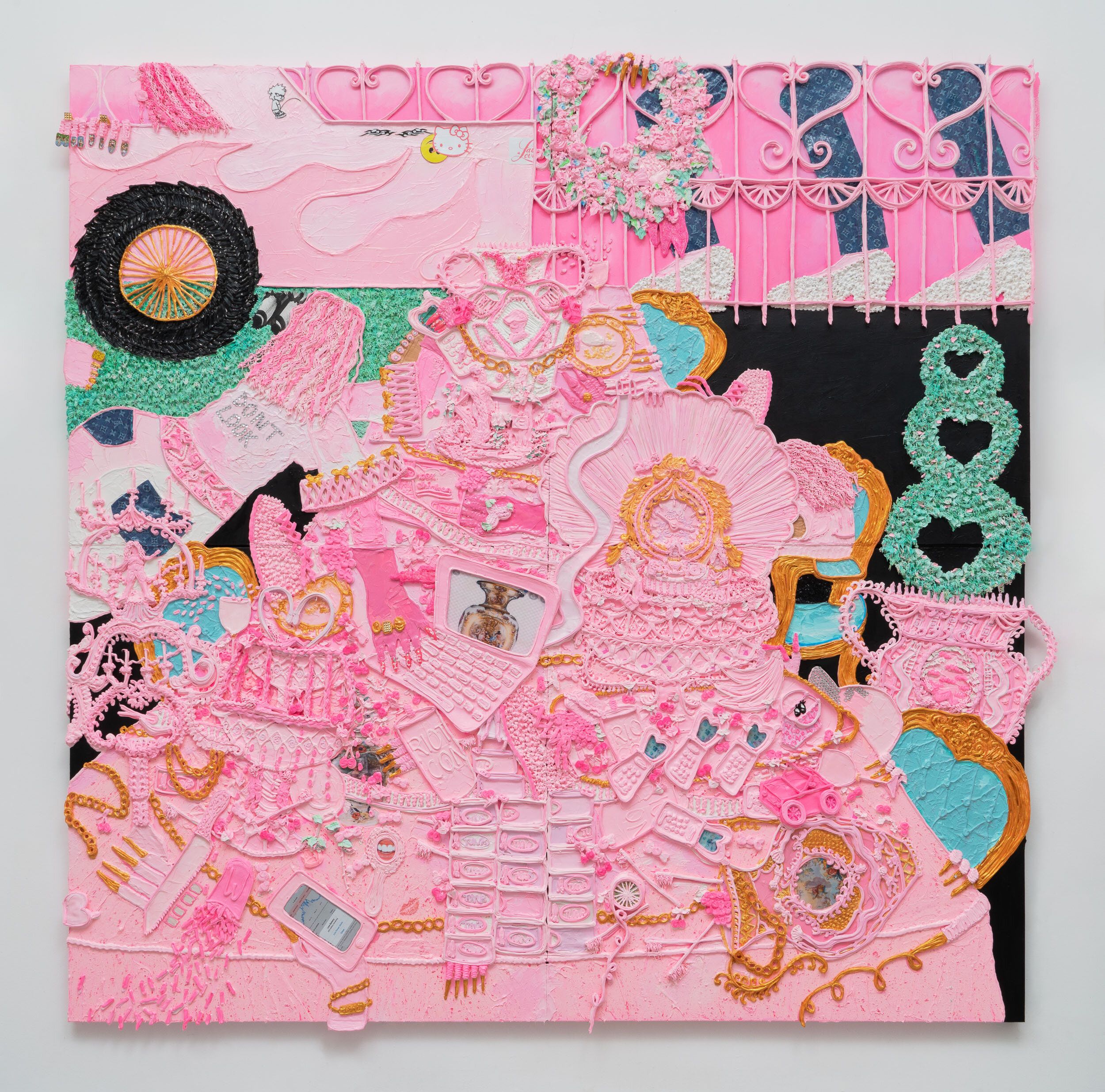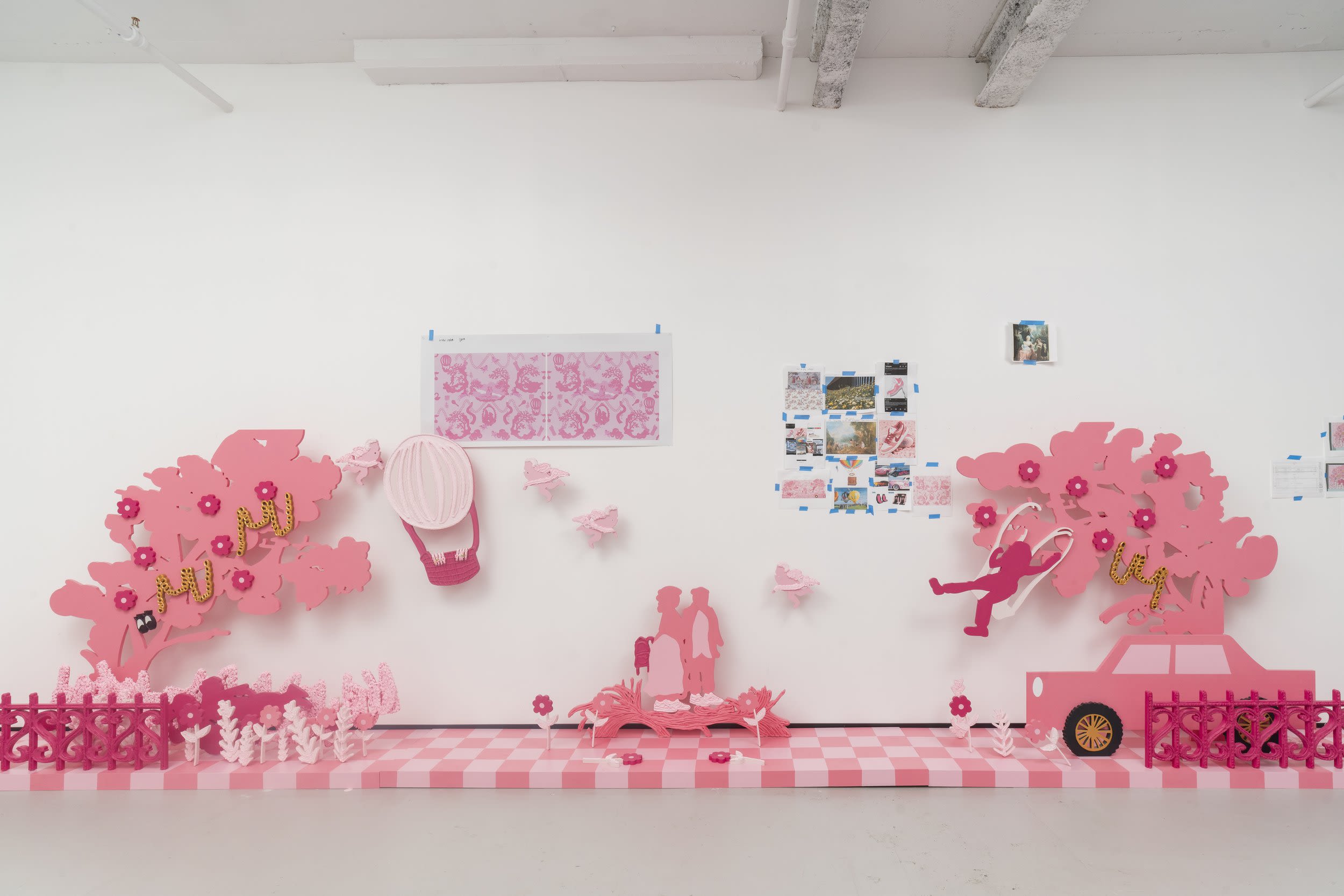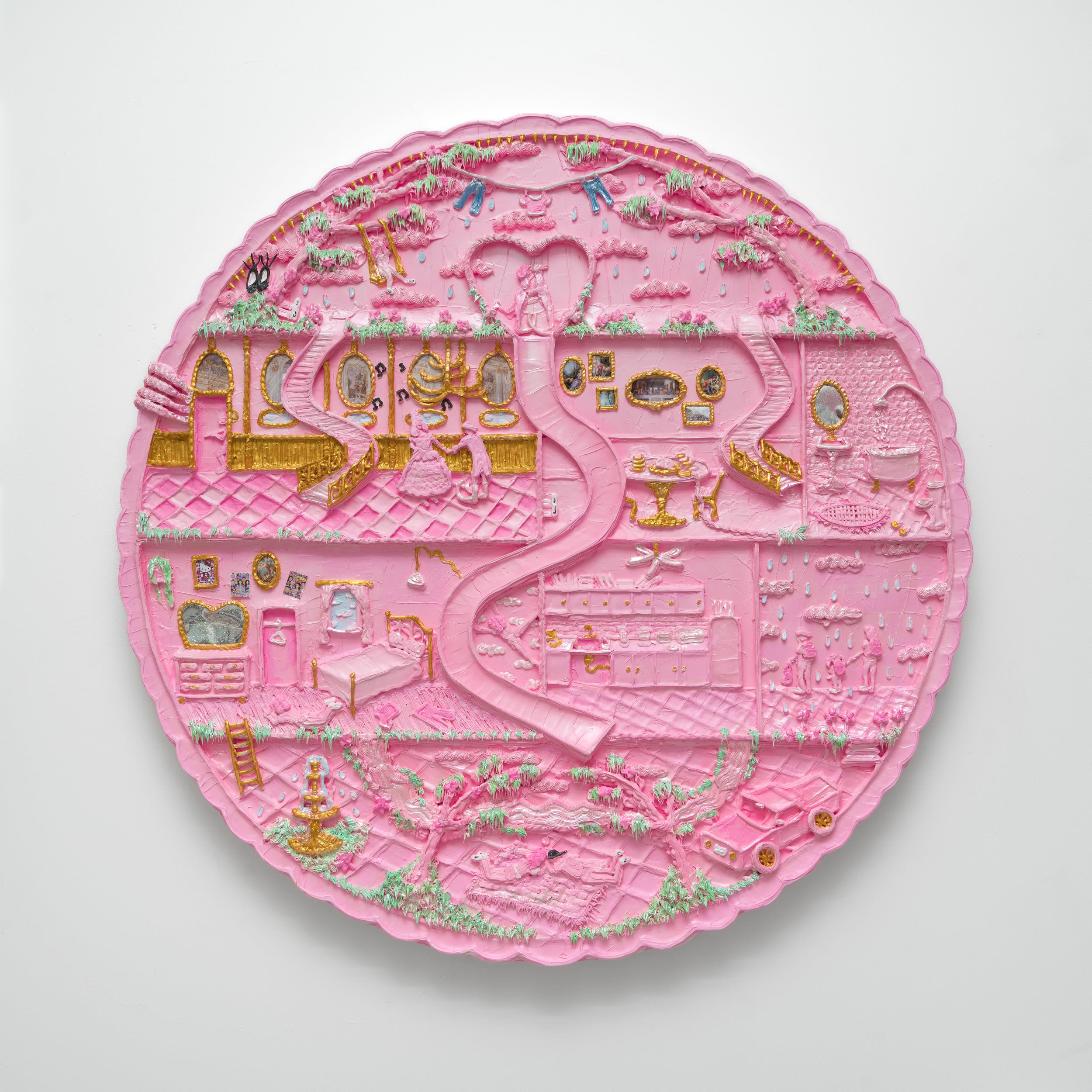BEST COLOR PALETTE
Yvette Mayorga Proves Pink Goes With Everything

by J. Howard Rosier (MFA 2018)
Monochromal, oversaturated, soothing—it’s the pink of panaderias, of architecture in Mexico.
Stereotypically, it is thought of as a girl’s color: consigned to the realm of Barbie dolls. Yet to School of the Art Institute of Chicago (SAIC) alum Yvette Mayorga (MFA 2016), the disarming nature of all-pink everything is a coercion, an invitation to look at what all this chicano and femme projection covers up.
“I like world building,” said Mayorga, a Chicago-based artist whose first East Coast solo exhibition, Thinking of You, is currently on display at the Aldrich Contemporary Art Museum in Ridgefield, Connecticut. Whether in smaller pieces with dimensions that resemble a blown-up locket, or in much larger ones that assume the role of art environments, her works ooze with surprise.
Is that golden-winged clock in The Procession (After 17th-century Vanitas) actually just a cake topper? Amid a backdrop of exaggerated swans and half-naked revelers, is the pink structure holding a row of horizontal figures in Ride or Die (2017) supposed to be a tomb?
“The large-scale works interact with the viewer's body and feel immersive, like you are stepping into the world I'm painting,” said Mayorga. “The smaller-scale works can do the exact same thing by creating miniature world building that viewers can peek into and also imagine themselves in relation to.”

Yvette Mayorga, The Procession (After 17th-century Vanitas), 2020. Image courtesy of the artist. Collection of El Museo del Barrio
Yvette Mayorga, The Procession (After 17th-century Vanitas), 2020. Image courtesy of the artist. Collection of El Museo del Barrio
With Mayorga’s work, viewers are asked to question colonialism’s impact on the canon—the way its insistence on supremacy inherently runs alternative histories off the road. “I’m ‘celebrating’ material/references of [art history] to include histories and bodies that were never part of the canon,” she said. “It's a satirical tactic to question our attraction to taste and class and question structures of power.”
This tactic manifests in a profound ornateness. Rhinestones, decals, glitter, wood, and other found objects stud Mayorga’s canvases like precious gemstones, set in snaking tributaries of acrylic administered with piping bags as a nod to her mother, who worked as a baker at a department store in the 1970s.
“I’m ‘celebrating’ material/references of [art history] to include histories and bodies that were never part of the canon.’’
“I worked many years with oil then I transitioned to found material, building material like plaster and food,” she explained. “Acrylic was a natural progression of my exploration of materials. It also has the perfect consistency that mimics frosting. It’s thick but also gooey and dries fast enough to continue to build upon layer after layer.” The result marries the heavy texture of a drip painting with the precision of a stone carving.
The approach has earned her multiple accolades, including a MAKER Grant from the Chicago Artists Coalition, an individual artist program grant from the city’s Department of Cultural Affairs and Special Events, and a Make a Wave grant from 3Arts. Her work has been featured in W Magazine, Vogue, and Hyperallergic. Mayorga’s large-scale installation, Pilgrimage to the Isle of Pink, is on view for the next 25 years for the City of Chicago’s permanent public art collection at O’Hare International Airport’s Terminal 5, and her works are in the permanent collections of 21c Museum Hotels, Cerámica Suro, Crystal Bridges Museum of American Art, DePaul Art Museum, El Museo del Barrio, John D. and Catherine T. MacArthur Foundation, Museum of Fine Arts, Boston, and New Mexico State University Art Museum.
SAIC was the first time Mayorga had the opportunity to focus solely on her work, and the first time she had her own studio space. “I used semester critiques as an opportunity to create a new immersive installation,” she said. “I would paint the walls of my studio, the floor and pipe with real frosting. I got in a tiny bit of trouble for using real food.” She credits several professors whose processes improved her thinking: Professor Emerit Candida Alvarez, Associate Professor L Vinebaum, Professor Emerit Joan Livingstone, Professor William O'Brien, and Professor Christine Tarkowski. Traveling to India with Professor Shaurya Kumar and Livingstone for a study abroad course was one of the most profound and inspiring experiences as a burgeoning artist in her twenties.

Yvette Mayorga, Del Otro Lado / The Other Side featuring 17 commissions. Image courtesy of the artist. Collection of the City of Chicago.
Yvette Mayorga, Del Otro Lado / The Other Side featuring 17 commissions. Image courtesy of the artist. Collection of the City of Chicago.

Yvette Mayorga, Lovers Paradise, from the "Surveillance Locket Series," 2022. Image courtesy of the artist
Yvette Mayorga, Lovers Paradise, from the "Surveillance Locket Series," 2022. Image courtesy of the artist

Yvette Mayorga, The Enchanted Party After François Boucher, The Enchanted Home, 2022. Image courtesy of the artist. Collection of Crystal Bridges Museum of American Art
Yvette Mayorga, The Enchanted Party After François Boucher, The Enchanted Home, 2022. Image courtesy of the artist. Collection of Crystal Bridges Museum of American Art

Yvette Mayorga, F* is for ICE 1975-2018 (After Portrait of Innocent X, c. 1650, Diego Velázquez), 2018. Image courtesy of the artist
Yvette Mayorga, F* is for ICE 1975-2018 (After Portrait of Innocent X, c. 1650, Diego Velázquez), 2018. Image courtesy of the artist
Mayorga’s inspiration clearly comes from the world around her. “Sometimes my favorite ideas have come to me while I’m sketching on a plane or having a conversation with someone about something unrelated to art,” she said.
In her studio, Mayorga has a large working table, where she creates a lot of the elements that she attaches to her paintings. “I always keep imagery related to what I'm currently working on to remain inspired and draw elements from my references,” she said. Despite her work’s rococo precision, Mayorga doesn’t keep to a specific workflow. Her ideas beget a ton of research, which in turn begets a ton of drawing—and the march toward translating these drawings into 3D. Unsurprisingly, the one constant is the piping.
“It’s a drawing tool for me,” she said. “I use it in a way you would use a pencil or paint brush. Then I follow the lines I laid out and build slowly over time.” Her paintings each take from months to about a year, and Mayorga relishes the time. As an artist, she is deliberate rather than freewheeling. “It's a beautiful exchange that happens with patience,” she said of her painting process.
After finishing a new body of work, she repaints her walls and floor, like a baker hitting the self-clean button on an oven.
“I find it to be refreshing and a palette cleanser,” Mayorga said. “It's also a way for me to remain creative with a fresh perspective and set of ideas.” ■
